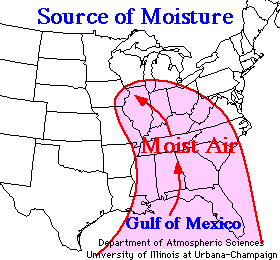|
|
. |
The States of Water
solid, liquid, gas
Water is known to exist in three different states; as a solid, liquid or
gas.

Rain, snow, and clouds are all made of up of some form of water.
Clouds are basically made up of
tiny water droplets and/or ice crystals. Snow flakes are simply
ice crystals while rain is just liquid water.

Water existing as a gas is called water vapor.
When referring to the amount of moisture in the air,
we are actually referring to the amount of water vapor.
If the air is described as "moist", that means the air contains
large amounts of water vapor.
Common sources of moisture for the United States are the warm,
moist air masses that occasionally flow
northward from the Gulf of Mexico and western Atlantic Ocean.

As cyclones
move eastward from the
Rockies, southerly winds ahead of these storm systems transport
the warm moist air northward.
This moisture is a necessary ingredient for precipitation.
If the moisture content of the air is very low, precipitation is unlikely
to develop.
|


